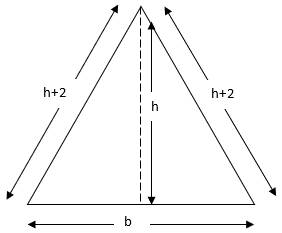Each of the equal sides of an isosceles triangle measures 2 cm more than its height, and the base of the triangle measure 12 cm. Find the area of the triangle.
Let height of triangle = h cm
Given: Base of the triangle (b) = 12 cm
Equal sides (a) = h + 2 cm

Now,
Area of a triangle = 1/2 × Base × Height
And,
Area of isosceles triangle = 1/4 × b√(4a2 – b2)
⇒ 1/2 × Base × Height = 1/4 × b√(4a2 – b2)
⇒ 1/2 × 12 × h = 1/4 × 12√[4(h + 2)2 – 122]
⇒ 6h = 3√(4h2 + 16h + 16-144)
⇒ 2h = √(4h2 + 16h-128)
On squaring both sides we get,
⇒ 4h2 = 4h2 + 16h – 128
⇒ 16h – 128 = 0
⇒ 16h = 128
![]()
⇒ h = 8 cm
Now,
Area of a triangle = 1/2 × Base × Height
= 1/2 × 12 cm × 8 cm
= 1/2 × 96 cm2
= 48 cm2
18